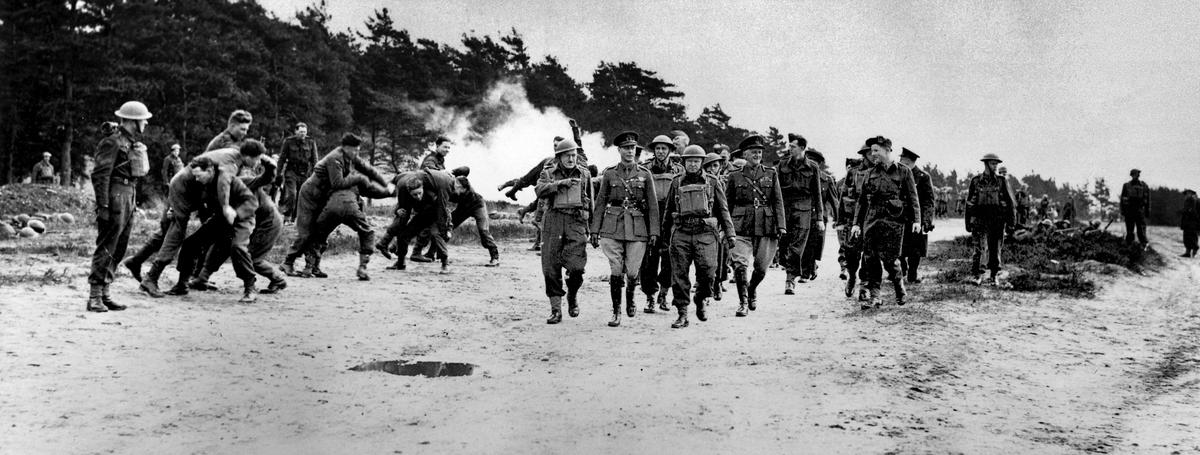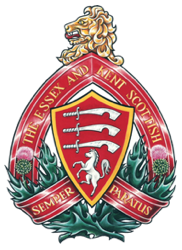Reconstruction of the Essex Scottish Regiment after Dieppe

His Majesty King George VI inspects the men of the Essex Scottish Regiment during training exercises as the regiment recovers from the Battle of Dieppe
On the afternoon of 19th August 1942, cooks in the Essex Scottish Regiment (ESR) prepared a large feast to feed the hundreds of infantrymen they expected to return from the raid on Dieppe that morning. To their horror, only forty-nine infantrymen and two officers of the regiment returned. The ESR had been decimated, along with the rest of the 4th Canadian Infantry Brigade. The meal, which had been prepared to feed hungry men after a successful operation, went cold that night; no one had the appetite to enjoy it.
The days after Dieppe were some of the bleakest in the regiment's history. Many officers of the ESR were killed or captured in the raid, including the regiment’s commanding officer Lieutenant-Colonel Fred Jasperson. Morale was at an all-time low. Many were furious at both the Germans and their own senior officers. The entire regiment grieved their friends and comrades. On 23 August, the regiment’s diarist wrote that “[the Essex Scottish Regiment] gives silent tribute to comrades who have fallen decisively that the Allies might gain experience and confidence in the opening of the oft-mentioned second front.” He added in capitals: “THEY HAVE NOT DIED IN VAIN.”
Rumors began spreading the day after the raid. Newspapers speculated on casualty numbers. War correspondents looked for stories among the survivors. Both German and British propagandists raced to put a patriotic spin on the Dieppe Raid. Parades and church services memorialized the raid on Dieppe throughout England and Canada. In Windsor, a memorial service was held at St Mary's Church and a Scottish parade with pipe band marched down Wyandotte Street. German radio broadcasts boasted of their decisive victory and photos of Canadian POWs decorated were featured on the front pages of their newspapers. Private memorial services were held for the men of the ESR and the 4th Brigade.
The reconstitution and retraining of the ESR began immediately after the catastrophe at Dieppe. On August 23rd, the first batch of 128 reinforcements arrived in the battalion. Men from the Royal Canadian Highlanders, and the Calgary Highlanders were transferred to reinforce the ESR’s 1st Battalion. Major J.H. Mothersill was promoted to lieutenant-colonel and assumed command of the regiment. By the end of August, Mothersill began training exercises and physical training for all ranks, including cooks, drivers, and other support personnel. The month of September was spent filling out the ranks with new recruits who arrived in batches of a hundred every week. Many reinforcements came from the Kent Regiment in Chatham-Kent. Training started back at the basics: drilling marches and formations, practicing fieldcraft, and studying tactics. By October, the regiment was back to capacity and training full-time. Seventeen-mile marches, maneuver exercises, and weapon training began in earnest. At the end of the month, several veterans of Dieppe were recommended for medals and awards. The investiture ceremony took place at Buckingham Palace, and the medals were presented by King George VI.
November and December 1942 were also filled with exercises and drills, although more advanced than before. The only exception was a brief pause to allow the men of the ESR to help harvest sugar beets. During this time, the Regiment began receiving the first letters from friends and peers captured at Dieppe. Letters were shared among the survivors and even exchanged with different regiments. All regiments who participated in Dieppe grew close-knit. Dieppe veterans from the Royal Hamilton Light Infantry or the Royal Regiment of Canada inquired about prisoners from the ESR and vice versa. There was a sense of common grief and anguish between the regiments of the 4th Brigade. The shared feelings of anguish and guilt drew them together. This inter-regiment comradery was spotted and cultivated by the officers. All future training operations were executed at the brigade level to cement this bond.
The ESR began its first training operations at the Brigade Battle School in January 1943. This was a new institution that aimed to standardize training and tactics among all the regiments of a brigade. The chief instructor of the school was Major Bruce J.S. Macdonald, an excellent military instructor and the future commander of the ESR’s 1st Battalion. Under his guidance, companies from each regiment practiced together and became familiar with one another. Training exercises ISLANDS and PICKWICK were the first of the cross-regimental operations that continued until early February. The month of February was spent in large brigade-sized training exercises PUNCH and ELM. These operations were beneficial, as the ESR got some valuable time in the field to harden the untested reinforcements.
The beginning of March was spent on Exercise SPARTAN, an army-sized training operation that spanned twelve days. SPARTAN was the largest and most complex training operation of the Second World War. The men of the ESR performed exceptionally. The regiment went days without food or sleep while marching and digging entrenched positions to test their limits. Despite these hardships, the Regiment was able to ambush and capture a whole battalion of the famous English Black Watch Highlanders Regiment. Regimental diaries from the 4th Brigade praised the actions of other regiments and the brigade in its entirety. The ESR once again operated at their full potential. Months of hard training and drills had restored the fighting strength of the regiment. The unit would not see combat again until 18 July 1944, supporting allied offensives after D-Day.
Story by Calvin Barrett, Canada Summer Jobs 2022 participant
with The Essex and Kent Scottish Regiment Association
Sources
- Battalion leadership in the Essex Scottish Regiment and the 4th Canadian Infantry Brigade during the Second World War by John James Maker, 2004
- Duty Nobly Done, The History of The Essex and Kent Scottish Regiment by Sandy Antal and Kevin R. Shackleton, 2006
- 1st Battalion The Essex Scottish Regiment 1939-1945 booklet, 1946
